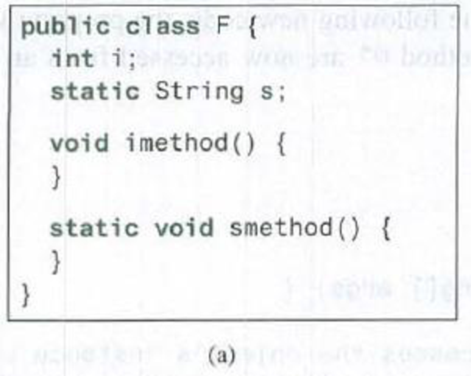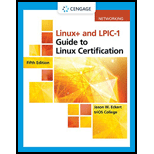
Introduction to Java Programming and Data Structures, Comprehensive Version (11th Edition)
11th Edition
ISBN: 9780134670942
Author: Y. Daniel Liang
Publisher: PEARSON
expand_more
expand_more
format_list_bulleted
Textbook Question
Chapter 9.7, Problem 9.7.1CP
Suppose the class F is defined in (a). Let f be an instance of F. Which of the statements in (b) are correct?


Expert Solution & Answer
Want to see the full answer?
Check out a sample textbook solution
Students have asked these similar questions
Write the SQL code that permits to implement the tables: Student and Transcript. NB: Add the constraints on the attributes – keys and other.
Draw an ERD that will involve the entity types: Professor, Student, Department and Course. Be sure to add relationship types, key attributes, attributes and multiplicity on the ERD.
Draw an ERD that represents a book in a library system. Be sure to add relationship types, key attributes, attributes and multiplicity on the ERD.
Chapter 9 Solutions
Introduction to Java Programming and Data Structures, Comprehensive Version (11th Edition)
Ch. 9.3 - Prob. 9.3.1CPCh. 9.3 - How do you define a class?Ch. 9.3 - How do you declare an objects reference variable?Ch. 9.3 - How do you create an object?Ch. 9.4 - Prob. 9.4.5CPCh. 9.4 - When will a class have a default constructor?Ch. 9.5 - Which operator is used to access a data field or...Ch. 9.5 - What is an anonymous object?Ch. 9.5 - Prob. 9.5.3CPCh. 9.5 - Is an array an object or a primitive-type value?...
Ch. 9.5 - Prob. 9.5.5CPCh. 9.5 - What is wrong in the following code? 1. class Test...Ch. 9.5 - Prob. 9.5.7CPCh. 9.6 - Prob. 9.6.1CPCh. 9.6 - Prob. 9.6.2CPCh. 9.6 - Which packages contain the classes Date, Random,...Ch. 9.7 - Suppose the class F is defined in (a). Let f be an...Ch. 9.7 - Prob. 9.7.2CPCh. 9.7 - Can you invoke an instance method or reference an...Ch. 9.9 - Prob. 9.9.1CPCh. 9.9 - Prob. 9.9.2CPCh. 9.9 - In the following code, radius is private in the...Ch. 9.10 - Prob. 9.10.1CPCh. 9.10 - Show the output of the following program: public...Ch. 9.10 - Show the output of the following code:Ch. 9.10 - Prob. 9.10.4CPCh. 9.11 - What is wrong in the following code? 1public class...Ch. 9.12 - If a class contains only private data fields and...Ch. 9.12 - If all the data fields in a class are private and...Ch. 9.12 - Is the following class immutable? public class A {...Ch. 9.13 - What is the output of the following program?...Ch. 9.14 - Prob. 9.14.2CPCh. 9.14 - Prob. 9.14.3CPCh. 9 - (The Rectangle class) Following the example of the...Ch. 9 - (The Stock class) Following the example of the...Ch. 9 - (Use the Date class) Write a program that creates...Ch. 9 - Prob. 9.4PECh. 9 - (Use the GregorianCa1endar class) Java API has the...Ch. 9 - (Stopwatch) Design a class named StopWatch. The...Ch. 9 - (The Account class) Design a class named Account...Ch. 9 - (The Fan class) Design a class named Fan to...Ch. 9 - (Geometry: n-sided regular polygon) In an n-sided...Ch. 9 - Prob. 9.10PECh. 9 - (Algebra: 2 2linear equations) Design a class...Ch. 9 - (Geometry: intersecting point) Suppose two line...Ch. 9 - (The Location class) Design a class named Location...
Additional Engineering Textbook Solutions
Find more solutions based on key concepts
Write a program that asks the user to input an integer named numDoubles. Create a dynamic array that can store ...
Problem Solving with C++ (10th Edition)
If a class is named Student, what name can you use for a constructor for this class?
Java: An Introduction to Problem Solving and Programming (8th Edition)
For the circuit shown, find (a) the voltage υ, (b) the power delivered to the circuit by the current source, an...
Electric Circuits. (11th Edition)
When displaying a Java applet, the browser invokes the _____ to interpret the bytecode into the appropriate mac...
Web Development and Design Foundations with HTML5 (8th Edition)
Given that y=ax3+7, which of the following are correct Java statements for this equations? int y = a x x (x +...
Java How to Program, Early Objects (11th Edition) (Deitel: How to Program)
The Do-Whi1e loop is a ______ type of loop. a. pretest b. posttest c. prequalified d. post iterative
Starting Out with Programming Logic and Design (5th Edition) (What's New in Computer Science)
Knowledge Booster
Learn more about
Need a deep-dive on the concept behind this application? Look no further. Learn more about this topic, computer-science and related others by exploring similar questions and additional content below.Similar questions
- 2:21 m Ο 21% AlmaNet WE ARE HIRING Experienced Freshers Salesforce Platform Developer APPLY NOW SEND YOUR CV: Email: hr.almanet@gmail.com Contact: +91 6264643660 Visit: www.almanet.in Locations: India, USA, UK, Vietnam (Remote & Hybrid Options Available)arrow_forwardProvide a detailed explanation of the architecture on the diagramarrow_forwardhello please explain the architecture in the diagram below. thanks youarrow_forward
- Complete the JavaScript function addPixels () to calculate the sum of pixelAmount and the given element's cssProperty value, and return the new "px" value. Ex: If helloElem's width is 150px, then calling addPixels (hello Elem, "width", 50) should return 150px + 50px = "200px". SHOW EXPECTED HTML JavaScript 1 function addPixels (element, cssProperty, pixelAmount) { 2 3 /* Your solution goes here *1 4 } 5 6 const helloElem = document.querySelector("# helloMessage"); 7 const newVal = addPixels (helloElem, "width", 50); 8 helloElem.style.setProperty("width", newVal); [arrow_forwardSolve in MATLABarrow_forwardHello please look at the attached picture. I need an detailed explanation of the architecturearrow_forward
- Information Security Risk and Vulnerability Assessment 1- Which TCP/IP protocol is used to convert the IP address to the Mac address? Explain 2-What popular switch feature allows you to create communication boundaries between systems connected to the switch3- what types of vulnerability directly related to the programmer of the software?4- Who ensures the entity implements appropriate security controls to protect an asset? Please do not use AI and add refrencearrow_forwardFind the voltage V0 across the 4K resistor using the mesh method or nodal analysis. Note: I have already simulated it and the value it should give is -1.714Varrow_forwardResolver por superposicionarrow_forward
- Describe three (3) Multiplexing techniques common for fiber optic linksarrow_forwardCould you help me to know features of the following concepts: - commercial CA - memory integrity - WMI filterarrow_forwardBriefly describe the issues involved in using ATM technology in Local Area Networksarrow_forward
arrow_back_ios
SEE MORE QUESTIONS
arrow_forward_ios
Recommended textbooks for you
 C++ Programming: From Problem Analysis to Program...Computer ScienceISBN:9781337102087Author:D. S. MalikPublisher:Cengage Learning
C++ Programming: From Problem Analysis to Program...Computer ScienceISBN:9781337102087Author:D. S. MalikPublisher:Cengage Learning EBK JAVA PROGRAMMINGComputer ScienceISBN:9781337671385Author:FARRELLPublisher:CENGAGE LEARNING - CONSIGNMENT
EBK JAVA PROGRAMMINGComputer ScienceISBN:9781337671385Author:FARRELLPublisher:CENGAGE LEARNING - CONSIGNMENT Microsoft Visual C#Computer ScienceISBN:9781337102100Author:Joyce, Farrell.Publisher:Cengage Learning,
Microsoft Visual C#Computer ScienceISBN:9781337102100Author:Joyce, Farrell.Publisher:Cengage Learning, C++ for Engineers and ScientistsComputer ScienceISBN:9781133187844Author:Bronson, Gary J.Publisher:Course Technology PtrProgramming Logic & Design ComprehensiveComputer ScienceISBN:9781337669405Author:FARRELLPublisher:Cengage
C++ for Engineers and ScientistsComputer ScienceISBN:9781133187844Author:Bronson, Gary J.Publisher:Course Technology PtrProgramming Logic & Design ComprehensiveComputer ScienceISBN:9781337669405Author:FARRELLPublisher:Cengage LINUX+ AND LPIC-1 GDE.TO LINUX CERTIF.Computer ScienceISBN:9781337569798Author:ECKERTPublisher:CENGAGE L
LINUX+ AND LPIC-1 GDE.TO LINUX CERTIF.Computer ScienceISBN:9781337569798Author:ECKERTPublisher:CENGAGE L

C++ Programming: From Problem Analysis to Program...
Computer Science
ISBN:9781337102087
Author:D. S. Malik
Publisher:Cengage Learning

EBK JAVA PROGRAMMING
Computer Science
ISBN:9781337671385
Author:FARRELL
Publisher:CENGAGE LEARNING - CONSIGNMENT

Microsoft Visual C#
Computer Science
ISBN:9781337102100
Author:Joyce, Farrell.
Publisher:Cengage Learning,

C++ for Engineers and Scientists
Computer Science
ISBN:9781133187844
Author:Bronson, Gary J.
Publisher:Course Technology Ptr

Programming Logic & Design Comprehensive
Computer Science
ISBN:9781337669405
Author:FARRELL
Publisher:Cengage

LINUX+ AND LPIC-1 GDE.TO LINUX CERTIF.
Computer Science
ISBN:9781337569798
Author:ECKERT
Publisher:CENGAGE L
Call By Value & Call By Reference in C; Author: Neso Academy;https://www.youtube.com/watch?v=HEiPxjVR8CU;License: Standard YouTube License, CC-BY